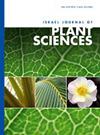根际细菌群落对水稻籽粒锌的有效动员
IF 0.9
4区 生物学
Q4 PLANT SCIENCES
引用次数: 4
摘要
大米等主食中的低锌与世界上许多国家的大规模锌营养不良密切相关。通过一些成本效益高的农艺方法对稻米进行锌生物强化对低收入农民来说很重要。为了探讨除了提高两个品种的产量外,提高锌在水稻籽粒中的生物利用度的可能性,在两年的田间试验中,对不同锌肥剂量与接种或不接种根际细菌群落的组合进行了评估。微生物接种+5kg Zn ha-1对一年制水稻的有效分蘖数、籽粒产量、籽粒和秸秆中的锌浓度和吸收量以及总锌吸收量在这两年中都是最高的。微生物接种+5kgZn-ha-1对一年稻和5kgZn-ha-1单独处理对一年水稻的产量分别比对照提高19.7-27.9%和17.1-20.4%。在土壤施用5kgZn-ha-1的条件下,脱谷粒中锌的最高浓度(10.9-1.1mg kg-1)和植酸的最低浓度(18.5-25.3g kg-1);然而,这些值与在微生物接种+5kg Zn ha-1(12.0-17.0mg Zn kg-1和19.2-26.9g植酸kg-1)下观察到的值相同。在这两年中,土壤施用锌的利用率都随着微生物接种的增加而增加,NDR 359的利用率相对高于PD 16。本文章由计算机程序翻译,如有差异,请以英文原文为准。
Effective zinc mobilization to rice grains using rhizobacterial consortium
Low Zn in staple food grains like rice is closely related to large scale Zn malnutrition in many countries of the World. Zinc biofortification of rice grains by some cost effective agronomic method is important for low income farmers. To explore the possibility of enhancing the bioavailability of Zn in rice grains besides higher yields of two cultivars, the combinations of varying Zn fertilizer doses with or without inoculation of rhizobacteria consortium under split plot design set up were evaluated in two years field trials. Microbial inoculation + 5 kg Zn ha-1 to I year rice crop resulted in the highest number of effective tillers, grain yields, Zn concentration and uptake in grains and straw and total Zn uptake in both years. Grain yield of rice during two years increased by 19.7-27.9 and 17.1-20.4 percent over control under treatments receiving microbial inoculation + 5 kg Zn ha-1 to I year rice and 5 kg Zn ha-1 alone to I year rice crop, respectively. The highest concentration of Zn (10.9-19.1 mg kg-1) and the lowest concentration of phytic acid (18.5-25.3 g kg-1) in dehulled rice grains were recorded with soil application of 5 kg Zn ha-1; however, the values were at par with those observed under microbial inoculation + 5 kg Zn ha-1 (12.0-17.0 mg Zn kg-1 and 19.2-26.9 g phytic acid kg-1). The percent utilization of soil applied Zn increased with microbial inoculation in both the years and it was relatively higher in NDR 359 as compared to PD 16.
求助全文
通过发布文献求助,成功后即可免费获取论文全文。
去求助
来源期刊

Israel Journal of Plant Sciences
生物-植物科学
CiteScore
1.90
自引率
0.00%
发文量
17
审稿时长
>12 weeks
期刊介绍:
The Israel Journal of Plant Sciences is an international journal of extensive scope that publishes special issues dealing with all aspects of plant sciences, including but not limited to: physiology, cell biology, development, botany, genetic
 求助内容:
求助内容: 应助结果提醒方式:
应助结果提醒方式:


